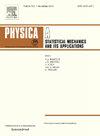异构网络上环境驱动的流行病模型的全局动力学和最优控制
IF 2.8
3区 物理与天体物理
Q2 PHYSICS, MULTIDISCIPLINARY
Physica A: Statistical Mechanics and its Applications
Pub Date : 2025-07-05
DOI:10.1016/j.physa.2025.130803
引用次数: 0
摘要
考虑环境传播和人际接触的异质性,提出了一种异构网络环境传播的传染病模型。首先,验证了该模型解的非负性和有界性。随后,导出基本复制数R0,作为控制模型动态的临界阈值。具体地说,当R0<;1时,无病平衡是全局渐近稳定的,对于R0>;1,疾病是一致持续的。进一步证明了局部平衡点在R0>;1和一些附加条件下是全局渐近稳定的。为了评估干预效果,我们将模型扩展到纳入控制策略,其中比较了统一免疫,目标免疫和熟人免疫对疾病控制的影响。结果表明,在同等免疫强度下,靶向免疫具有较好的疾病抑制效果。此外,应用Pontryagin的最大值原理,我们证明了同时实施多个控制措施可以最大化干预效果,同时最小化操作成本。最后,通过数值模拟对理论结果进行了解释,并比较了不同程度分布下免疫和综合防治的效果。结果表明,在不同程度分布下,综合防治是预防和控制疾病传播的最佳选择。本文章由计算机程序翻译,如有差异,请以英文原文为准。
Global dynamics and optimal control of an environmentally-driven epidemic model on heterogeneous networks
Considering environmental transmission and the heterogeneity of contacts between people, an infectious disease model with environmental transmission on a heterogeneous network is proposed. First, the non-negativity and boundedness of solutions for this model are verified. Subsequently, the basic reproduction number is derived, serving as the critical threshold governing the model’s dynamics. Specifically, the disease-free equilibrium is globally asymptotically stable when , disease is uniformly persistent for . Furthermore, the endemic equilibrium is proved to be globally asymptotically stable when and under some additional conditions. To evaluate intervention efficacy, we extend the model to incorporate control strategies, where the effects of uniform immunization, target immunization and acquaintance immunization on disease control are compared. The results demonstrate that targeted immunization achieves superior disease suppression under equivalent immunization intensities. Additionally, applying Pontryagin’s maximum principle, we prove that simultaneous implementation of multiple controls maximizes intervention efficacy while minimizing operational costs. Finally, the theoretical results are explained by numerical simulations and the effects of immunization and comprehensive control are compared under different degree distributions. The results show that comprehensive control is the best choice to prevent and control the spread of the disease under different degree distributions.
求助全文
通过发布文献求助,成功后即可免费获取论文全文。
去求助
来源期刊
CiteScore
7.20
自引率
9.10%
发文量
852
审稿时长
6.6 months
期刊介绍:
Physica A: Statistical Mechanics and its Applications
Recognized by the European Physical Society
Physica A publishes research in the field of statistical mechanics and its applications.
Statistical mechanics sets out to explain the behaviour of macroscopic systems by studying the statistical properties of their microscopic constituents.
Applications of the techniques of statistical mechanics are widespread, and include: applications to physical systems such as solids, liquids and gases; applications to chemical and biological systems (colloids, interfaces, complex fluids, polymers and biopolymers, cell physics); and other interdisciplinary applications to for instance biological, economical and sociological systems.

 求助内容:
求助内容: 应助结果提醒方式:
应助结果提醒方式:


